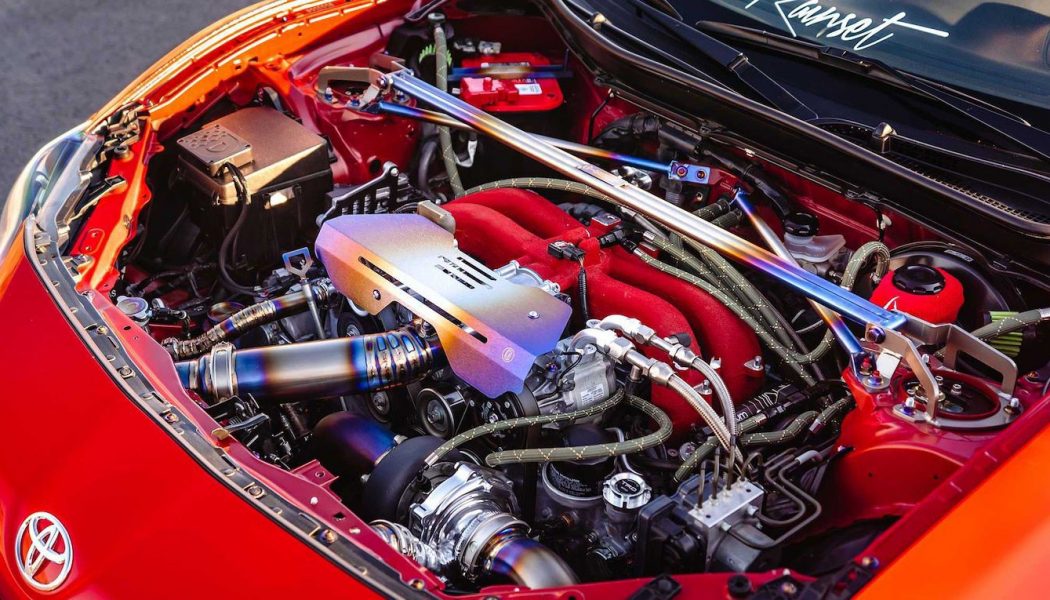Toyota’s legacy as an engine designer and producer is inextricably intertwined with the inline-six. After all, four of the power plants on this list fall into that configuration, including the desirable 2JZ-GTE from the A80 Supra. But Toyota’s talents go beyond six-cylinder engines. Think about the high-revving V-10 from the Lexus LFA or the flat-four the company co-developed with Subaru for the 86 and BRZ.
More Videos
From the factory-boosted Mk IV Supra mill you’re familiar with to the fabled GT-One Le Mans engines you’ll only find in a museum, here are Toyota’s top 10 engines in no particular order:
- 2JZ-GTE Inline-Six
- 1JZ-GTE Inline-Six
- 4A-GE Inline-Four
- 3S-GTE Inline-Four
- 4U-GSE / FA20 Flat-Four
- 1LR-GUE V-10
- 7M-GTE Inline-Six
- 2ZZ-GE Inline-Four
- R36V V-8
- 3M Inline-Six
2JZ-GTE Inline-Six
MOST OBVIOUS PLACE TO FIND ONE: 1993-1998 Toyota Supra Turbo
THE NUMBERS: 320 hp and 315 lb-ft of torque
WHY YOU WANT ONE: The Mk IV Supra owes its success to the six-cylinder 2JZ-GTE underneath its hood. For more than two decades, the 2JZ’s nearly indestructible nature has been proven on applications pushing out as much as 2,000 hp. The brute of a cast-iron block makes all of this possible and means as much as 750 hp can be yours with very few mods. (This will decimate all. – SD)
1JZ-GTE Inline-Six
MOST OBVIOUS PLACE TO FIND ONE: Japanese Domestic Market (JDM) 1996-2001 Toyota Chaser
THE NUMBERS: 280 hp and 280 lb-ft of torque
WHY YOU WANT ONE: You thought the 2JZ was Toyota’s star engine and you’re mostly right. Find the right 1JZ, though, and you’ve got a close second. Third-generation models (available on Japanese-market Chasers, Soarers, and Mark IIs) feature a smaller-displacement, 2.5-liter BEAMS architecture, VVT-i, and a single CT15B turbo, which allows for a whole lot more room when cramming one into the engine bay of something like a Lexus SC or GS.
4A-GE Inline-Four
THE NUMBERS: 112 hp and 97 lb-ft of torque
WHY YOU WANT ONE: The 4A-GE’s 112 hp might not sound like a lot, but those ponies matter less than this engine’s history. One of the first fuel-injected, four-cylinder powerplants to feature a twin-cam, 16-valve layout, this mill was loosely based off of Cosworth’s legendary BDA (Belt Drive, A Type) series of engines. Nearly three decades later and the aftermarket continues to support Toyota’s classic four-banger as much as ever.
3S-GTE Inline-Four
MOST OBVIOUS PLACE TO FIND ONE: 1991-1999 Toyota MR2 Turbo
THE NUMBERS: 200 hp and 200 lb-ft of torque
WHY YOU WANT ONE: Toyota’s factory-turbocharged 3S-GTE is to MR2s and Celica All-Tracs what the 2JZ-GTE is to the Supra. Toyota produced four generations of 3S-GTEs, the last of which bangs out about 260 hp, but it’s the second-gen version us North Americans are most familiar with. The 2.0-liter four-cylinder mill features all sorts of high-end engineering, like piston-cooling oil squirters, an air-to-air intercooler, and a twin-entry turbine housing that tuners wouldn’t recognize the importance of for another decade.
4U-GSE / FA20 Flat-Four
MOST OBVIOUS PLACE TO FIND ONE: 2013-2016 Scion FR-S
THE NUMBERS: 197 hp and 151 lb-ft of torque
WHY YOU WANT ONE: Toyota’s and Subaru’s joint-effort boxer engine isn’t the most powerful four-cylinder either company’s ever made, but that doesn’t make it any less special. Call it a hodgepodge of Toyota and Subie technology if you want: Its square configuration and Yamaha-derived heads are very much Toyota-like, and its boxer configuration is so obviously Subaru. AVCS (Active Valve Control System) on both camshafts and a lightweight aluminum block and cylinder heads that—together with all of the engine’s internals—results in a whopping 12.5:1 compression ratio, are part of what makes the FA20 such a capable powerplant.
1LR-GUE V-10
MOST OBVIOUS PLACE TO FIND ONE: 2011-2012 Lexus LFA
THE NUMBERS: 552 hp and 354 lb-ft of torque
WHY YOU WANT ONE: You’ll never own one, but you can still appreciate the LFA’s 4.8L V-10 engine. Despite its rather large displacement, the engine spins to 9,000 rpm. Its pistons are forged and its rods titanium. A dry-sump oil setup comes standard, as do individual throttle bodies for each cylinder. Toyota ditched the whole 90-degree V-10 premise that nearly every other automaker relies on for a 72-degree layout that results in a better-balanced rotating assembly and fewer pounds. Not that any of that matters to you and your Celica.
7M-GTE Inline-Six
MOST OBVIOUS PLACE TO FIND ONE: 1987-1992 Toyota Supra Turbo
THE NUMBERS: 232 hp and 240 lb-ft of torque
WHY YOU WANT ONE: Don’t kid yourself into thinking the third-generation Supra’s 7M-GTE is anything like the 2JZ. Still, the older engine might’ve just set the precedent for the forthcoming Mk IV Supra’s unbelievable powerplant—and for that it deserves credit. For a while, this forced induction engine was the most powerful unit Toyota offered. It’s also the thing that truly severed the Supra from its Celica heritage.
2ZZ-GE Inline-Four
THE NUMBERS: 180 hp and 133 lb-ft of torque
WHY YOU WANT ONE: The 2ZZ-GE and its VVTL-i valvetrain was Toyota’s response to Honda’s notorious VTEC system. Sort of. Although the 2ZZ doesn’t receive the same sort of support from the aftermarket and its capabilities fall a bit short compared to Honda’s K20A Type R engine, the Toyota engine remains a worthy hunk of metal in stock form. Designed by Yamaha, the 2ZZ-GE features a lofty 11.5:1 compression ratio; an unprecedented, all-aluminum design; and the sort of balanced bore-to-stroke ratio that won’t make you feel guilty revving it to redline all day long.
R36V V-8
MOST OBVIOUS PLACE TO FIND ONE: 1998-1999 Toyota GT-One
THE NUMBERS: 608 hp and 479 lb-ft of torque
WHY YOU WANT ONE: You can’t buy Toyota’s twin-turbocharged 3.6-liter eight-cylinder LMGTP engine, but that doesn’t make it any less special. Built for the Le Mans racers it was designed for in limited quantities (as well as for the two road-going versions the rules called for), the R36V is made up of a carbon-fiber block that’s derived from Toyota’s Group C cars of the 1980s. None of this made Toyota particularly famous during its late-1990s Le Mans stint. Still, this powertrain managed to take the racer to 60 miles per hour in a mere 3.2 seconds and up to a top speed of 236 mph.
3M Inline-Six
THE NUMBERS: 150 hp and 130 lb-ft of torque
WHY YOU WANT ONE: The straight-six that powered what many consider the world’s first Japanese supercar might not seem all that impressive today, but it was the stuff of legend 50-plus years ago. Toyota began to solidify its longstanding relationship with Yamaha with this powerplant. In this case, Yamaha took Toyota’s pre-existing Crown engine and made it better with a twin-cam head and three two-barrel Solex carbs.










